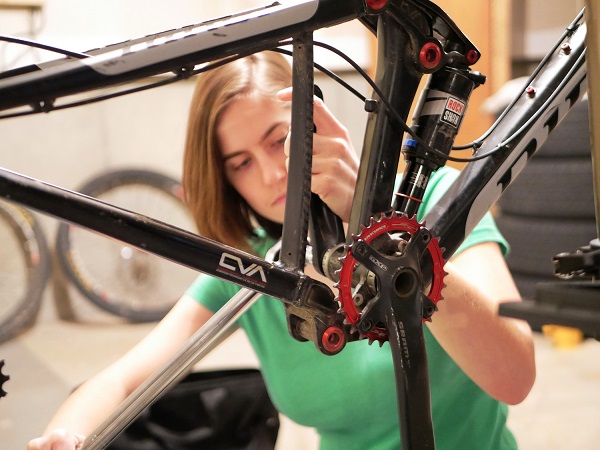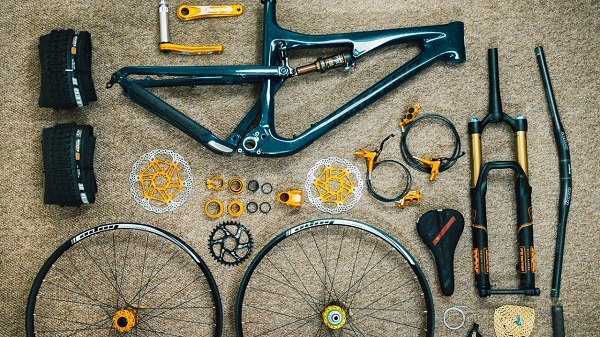
17 Apr Can you build your own mountain bike?
Most people know that mountain biking is the most popular off-road sport in the world. But what many people don’t know is that building your own bike is incredibly easy, safe, and rewarding. In this guide, we’ll show you how to build your own mountain bike. The process is simple and the material list is minimal. This project will get you on your way to crafting a hand-crafted bike that’s fit for any road or trail.
Can you build your own mountain bike?

Building your own bike is an inexpensive way to learn about engineering, physics, and mechanics. It’s also a fun project that will foster creativity and experimentation in science as well as exercise – without the associated gym or cost of lifting weights. Mountain biking is a great hobby to develop both physical and mental fitness. Safety is critical while building, so be sure you use your brain as well as tooling around on the forest floor! Here are some tips that will help in learning how to build your own bike.
How to build a mountain bike?
Before buying a mountain bike, you’ll need to understand the basics of building an actual model. To build your own, all you really have to do is observe what’s actually being displayed in stores but keep it simple by following this list:
Frame Material
Carbon fiber tubing with some steel reinforcement. Reinforcing material like carbon can be purchased at any home improvement store and welding supplies are commonly available, as well as bicycle chains or tubes that could be used to fit with the frame. Look at the bike frame size measurement.
Wheels
Ball bearings can be purchased at a bike parts store or ordered them online from sites. Use wheel bearings instead of tapered rollers because they don’t require lubrication and are more durable in rust prone areas such as upstate New York. You will want metal clutches, spokes, and rims. Although you could use plastic, it wouldn’t fare well against the rocky terrain. Keep reading https://pluginid.com/is-it-worth-getting-a-bike-repair-stand/
Aerodynamics
Composite tubing work well for frames with higher requirements on aerodynamic capabilities, such as the suspension and brakes, but steel or titanium are often better choices because they don’t rust. Steel is common in carbon fiber bike models since it can be widely purchased at a home improvement store near you, along with welding equipment to reinforce them during construction.
Handlebar
Handlebars vary in shape and action. They can differ from a completely straight grip to a lock-on twist shifter configuration. In the latter design, the handlebar lever actuates the brakes. Also called “bar ends,” these bars are comparatively easy to attach to any type of frame by types like a mountain bike, cross country, or racing bikes since there aren’t many possible combinations that would make it impossible for their installation.
Brake Handlebars
If you’re attempting to attach a bicycle brake lever to handlebars that have a shifter and derailleur, it will be very difficult. In this case, the choice is between traditional drop bar mountain bikes or braked front coaster brakes. The former works better for locking up a bike with a long-travel suspension due to space constraints, but it does put additional stress on your arms holding down independent braking systems.
Suspension
The kind of suspension system you’re looking for can affect your choice of equipment. For example, if a front shock absorber will be the first main element in the bike’s design quality, then always choose it instead of an air fork since they provide more preciseness and go flat fast when compared to forks. The former also has other advantages such as a higher possibility to safely power over bumps before bottoming out but losing steering ability than bikes with air forks. However, if you do have to choose between these two features, then the weight of a shock will add extra weight than what an air fork would offer, but they are both much better choices compared with rigid suspension or no suspension at all. Other types of tensioned bicycle wheels usually include straight-pull brakes. These ones allow for greater versatility in attaching additional parts and accessories like rack systems, lights and fenders.
Gears
Before you think of investing in a bike with more gears, keep on beating the road riding. They add weight and are nothing more than playthings when they’re not being used, so don’t forget that it’s set out there to get from point A to B. This is especially true for front cassette drop derailleur equipped bikes which can be bulky (causing greater strain on your arms) and heavy compared with low gear drive or single speed bikes. 4-10 derailleur-equipped bikes are a great choice for those who want to ride further without getting tired of pedaling, especially when the weather is hot and you can’t find anyone passing by your way. However, if all you need is a bike in situations where there’s no one around even, then front or rear cassette drop or traditional derailleurs may suit you better since they have a smaller footprint compared with other designs.
Saddle
A saddle is only as comfortable as the human behind it. However, this feature often determines whether or not you choose a high-quality bicycle over ones with a great frame but uncomfortable saddles such as banana seats and bumperettes (traditional cross country bike).
A simple yet practical tip from experienced riders would be to get something that fits your crotch. It’s much easier for both of your body parts to tackle the rigors of riding in good shape. If you begin to feel like no matter how hard you pedal, there’s not enough oomph behind your efforts but only a harsh jabbing feeling between the legs, grab a new saddle and then ride!
Brakes
Bikes with front or rear calipers are great for those who love the thrill of stopping in motion. Simply be aware that turning regular wheels won’t stop them (at least not quickly). In addition, if it has six or fewer wheels with disc brakes (an oft-used option), it can be hard to figure how and when you must apply the brake, what happens if there’s a problem in front while braking and because of this, sometimes bike can easily go out of control. Front derailleur equipped bikes are best for those who want to stop ‘anytime,’ which is more reasonable than traditional high gear designs where stopping distance depends on foot traction force.
Conclusion
If you have always wanted to build your own mountain bike, but didn’t know where to start, then this blog post is for you. This post will provide you with a step-by-step guide on how to build your own mountain bike. The steps in this guide are easy and do not require any specialized skills or tools. However, the materials needed will vary depending on the type of bike that you want to build.

No Comments